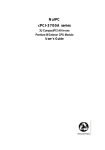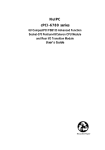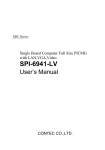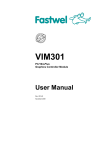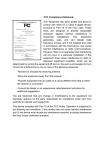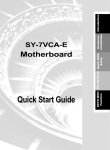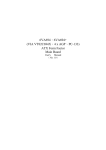Download ROBO-603 User`s Manual
Transcript
Preface ROBO-603 Embedded System Board User's Manual P/N: 861106030041 Version 1.0 Copyright © Portwell, Inc., 2001. All rights reserved. All other brand names are registered trademarks of their respective owners. Robo-603 User’s Manual Preface Manual Objectives This manual describes in detail the Portwell Inc. ROBO-603 Embedded System Board. We have tried to include as much information as possible but we have not duplicated information that is provided in the standard IBM Technical References, unless it proved to be necessary to aid in the understanding of this board. We strongly recommend that you study this manual carefully before attempting to interface with ROBO-603 or change the standard configurations. Whilst all the necessary information is available in this manual we would recommend that unless you are confident, you contact your supplier for guidance. Please be aware that it is possible to create configurations within the CMOS RAM that make booting impossible. If this should happen, clear the CMOS settings, (see the description of the Jumper Settings for details). If you have any suggestions or find any errors concerning this manual and want to inform us of these, please contact our Customer Service department with the relevant details. Robo-603 User’s Manual Preface Table of Contents How to Use This Manual Chapter 1. Introduction 1.1 System Overview............................................................................................................ 1 – 1 1.2 Check List ...................................................................................................................... 1 – 1 1.3 System Specifications..................................................................................................... 1 – 2 1.4 System Architecture ....................................................................................................... 1 – 5 1.4.1 VIA VT82C694X.................................................................................................... 1 – 6 1.4.2 DRAM Interface...................................................................................................... 1 – 6 1.4.3 AGP Interface.......................................................................................................... 1 – 7 1.4.4 PCI Interface ........................................................................................................... 1 – 7 1.4.5 VIA VT82C686A.................................................................................................... 1 – 8 1.4.6 IDE Interface (Bus Master Capability and Synchronous DMA Mode) ................... 1 – 9 1.4.7 USB......................................................................................................................... 1 – 9 1.4.8 SMI Lynx3DM SM721 VGA Controller ................................................................ 1 – 10 1.4.9 Panel Interface......................................................................................................... 1 – 12 1.4.10 Zoom Video Port................................................................................................... 1 – 13 1.4.11 TV Encoder ........................................................................................................... 1 – 14 1.4.12 Ethernet ................................................................................................................. 1 – 15 1.4.13 Compact Flash Interface........................................................................................ 1 – 16 1.4.14 Panel Link Interface (Optional)............................................................................. 1 – 16 Chapter 2. Hardware Configuration Setting 2.1 Audio / USB Daughter Board Jumper & Connector Layout .......................................... 2 – 1 2.2 Audio / USB Daughter Board Jumper & Connector List ............................................... 2 – 1 2.3 Main Board Jumpers & Connectors Layout Diagram .................................................... 2 – 3 2.4 Main Board Jumpers & Connectors List ........................................................................ 2 – 4 2.5 Setting Jumpers .............................................................................................................. 2 – 6 2.5.1 Clear CMOS (J3)..................................................................................................... 2 – 6 2.5.2 COM3 / 4 Pin 9 Signal Select (J5 / J4).................................................................... 2 – 7 2.5.3 COM2 RS-232/422/485 Select (J6, J7)................................................................... 2 – 8 2.6 Connector Definitions .................................................................................................... 2 – 9 2.6.1 Power Connector 1 (PWR1).................................................................................... 2 – 9 2.6.2 LCD Inverter Connector (J1) .................................................................................. 2 – 9 2.6.3 Signal Configuration – LCD Inverter Connector (J1) ............................................. 2 – 9 2.6.4 Auxiliary Power Connector (J2).............................................................................. 2 – 10 2.6.5 Ethernet 1 / 2 LED Connector (CN1)...................................................................... 2 – 10 2.6.6 Signal Description – Ethernet 1 / 2 LED Connector (CN1) .................................... 2 – 10 2.6.7 Zoom Video Port Connector (CN2) ........................................................................ 2 – 11 2.6.8 Signal Description – Zoom Video Port Connector (CN2)....................................... 2 – 11 2.6.9 Video Port Interface I/O Compliance...................................................................... 2 – 12 2.6.10 Primary LCD Panel Connector (CN3)................................................................... 2 – 13 2.6.11 Secondary LCD Panel Connector (CN4)............................................................... 2 – 14 2.6.12 Signal Description – Primary & Secondary LCD Panel Connector (CN3, CN4).. 2 – 15 2.6.13 Signal Configuration – DSTN & TFT Panel Displays .......................................... 2 – 16 2.6.14 CD-ROM Audio Input Connector (CN5) .............................................................. 2 – 18 Robo-603 User’s Manual Preface 2.6.15 Signal Configuration – CD-ROM Input Connector (CN5).................................... 2 – 18 2.6.16 Audio / TV Output Connector (CN6).................................................................... 2 – 19 2.6.17 Signal Description – Audio / TV Output Connector (CN6) .................................. 2 – 19 2.6.18 Pin Header Serial Port 1 / 2 / 3 / 4 Connector in RS-232 Mode (CN7)................. 2 – 20 2.6.19 Serial Port 1 / 2 / 3 / 4 with External DB9 Connector ........................................... 2 – 21 2.6.20 Signal Description – Serial Port 1 / 2 / 3 / 4 Connector in RS-232 Mode (CN7).. 2 – 21 2.6.21 Pin Header Serial Port 2 Connector (CN7 / Pin 11~20) in RS422 Mode.............. 2 – 22 2.6.22 Signal Description – Serial Port 2 in RS422 Mode ............................................... 2 – 22 2.6.23 Pin Header Serial Port 2 Connector (CN7 / Pin 11~20) in RS485 Mode.............. 2 – 22 2.6.24 Signal Description – Serial Port 2 in RS485 Mode ............................................... 2 – 23 2.6.25 PC104 Connector (CN8, CN9).............................................................................. 2 – 24 2.6.26 Signal Description – PC104 Connector (CN8, CN9) ............................................ 2 – 25 2.6.26.1 Address......................................................................................................... 2 – 25 2.6.26.2 Data .............................................................................................................. 2 – 25 2.6.26.3 Commands.................................................................................................... 2 – 26 2.6.26.4 Transfer Response ........................................................................................ 2 – 27 2.6.26.5 Controls ........................................................................................................ 2 – 27 2.6.26.6 Interrupts ...................................................................................................... 2 – 27 2.6.26.7 Bus Arbitration............................................................................................. 2 – 28 2.6.27 Keyboard and PS/2 Mouse Connector (CN10) ..................................................... 2 – 28 2.6.28 Signal Description – Keyboard / Mouse Connector (CN10) ................................. 2 – 28 2.6.29 IDE Device Connector (CN11) ............................................................................. 2 – 29 2.6.30 Signal Description – IDE Device Connector (CN11)............................................ 2 – 30 2.6.31 CPU Fan Connector (CN12) ................................................................................. 2 – 31 2.6.32 Signal Description – CPU Fan Connector (CN12)................................................ 2 – 31 2.6.33 Front Panel Connector (CN13).............................................................................. 2 – 31 2.6.34 Signal Description – Front Panel Connector (CN13) ............................................ 2 – 31 2.6.35 Floppy Disk Connector (FLP1) ............................................................................. 2 – 32 2.6.36 Signal Description – Floppy Disk Connector (FLP1) ........................................... 2 – 33 2.6.37 IrDA Connector (IR1) ........................................................................................... 2 – 33 2.6.38 Signal Configuration – IR Connector (IR1) .......................................................... 2 – 34 2.6.39 10/100 BASE-TX Ethernet Connector (LAN1, LAN2 / ECM-5610 only) ........... 2 – 34 2.6.40 Signal Description – 10/100Base-Tx Ethernet Connector (LAN1, LAN2 / ECM-5610 only) .......................................................................................................................................... 2 – 34 2.6.41 Panel Link Connector (PL1, Optional).................................................................. 2 – 34 2.6.42 Signal Description – Panel Link Connector (PL1, Optional) ................................ 2 – 35 2.6.43 Parallel Port Connector (PNT1) ............................................................................ 2 – 36 2.6.44 DB25 Parallel Port Connector............................................................................... 2 – 37 2.6.45 Signal Description – Parallel Port (PNT1) ............................................................ 2 – 38 2.6.46 USB Connector (USB1) ........................................................................................ 2 – 38 2.6.47 Signal Description – USB Connector (USB1) ...................................................... 2 – 39 2.6.48 CRT Connector (VGA1) ....................................................................................... 2 – 39 2.6.49 Signal Description – CRT Connector (VGA1)...................................................... 2 – 39 2.6.50 LCD Backlight Brightness Adjustment Connector (VR1)..................................... 2 – 40 2.6.51 STN LCD Contrast Adjustment Connector (VR2)................................................ 2 – 40 Robo-603 User’s Manual Preface Chapter 3. System Installation 3.1 Installation Procedure..................................................................................................... 3 – 1 3.2 Safety Precautions .......................................................................................................... 3 – 1 3.3 Socket 370 Processor ..................................................................................................... 3 – 1 3.3.1 Installing Pentium III / Celeron CPU ...................................................................... 3 – 1 3.3.2 Main Memory.......................................................................................................... 3 – 2 Chapter 4. BIOS Setup Information 4.1 Starting Setup ................................................................................................................. 4 – 1 4.2 Using Setup .................................................................................................................... 4 – 2 4.2.1 Navigating Through The Menu Bar ........................................................................ 4 – 2 4.2.2 To Display a Sub Menu........................................................................................... 4 – 3 4.3 Getting Help ................................................................................................................... 4 – 3 4.4 In Case of Problems ....................................................................................................... 4 – 3 4.5 Main Menu ..................................................................................................................... 4 – 4 4.5.1 Setup Items.............................................................................................................. 4 – 5 4.5.1.1 Standard CMOS Features............................................................................... 4 – 5 4.5.1.2 Advanced BIOS Features ............................................................................... 4 – 5 4.5.1.3 Advanced Chipset Features ............................................................................ 4 – 5 4.5.1.4 Integrated Peripherals..................................................................................... 4 – 5 4.5.1.5 Power Management Setup .............................................................................. 4 – 5 4.5.1.6 PNP / PCI Configuration Setup...................................................................... 4 – 5 4.5.1.7 Frequency / Voltage Control .......................................................................... 4 – 5 4.5.1.8 Load Fail-Safe Defaults.................................................................................. 4 – 5 4.5.1.9 Load Optimized Defaults ............................................................................... 4 – 5 4.5.1.10 Supervisor / User Password.......................................................................... 4 – 6 4.5.1.11 Save & Exit Setup ........................................................................................ 4 – 6 4.5.1.12 Exit Without Save ........................................................................................ 4 – 6 4.5.2 Standard CMOS Setup ............................................................................................ 4 – 7 4.5.2.1 Main Manu Selection ..................................................................................... 4 – 8 4.5.2.2 IDE Adapters.................................................................................................. 4 – 9 4.5.3 Advanced BIOS Features ........................................................................................ 4 – 10 4.5.3.1 Virus Warning ................................................................................................ 4 – 10 4.5.3.2 CPU Internal Cache/External Cache .............................................................. 4 – 10 4.5.3.3 CPU L2 Cache ECC Checking....................................................................... 4 – 11 4.5.3.4 Quick Power On Self Test.............................................................................. 4 – 11 4.5.3.5 First/Second/Third/Other Boot Device........................................................... 4 – 11 4.5.3.6 Swap Floppy Drive......................................................................................... 4 – 11 4.5.3.7 Boot Up Floppy Seek ..................................................................................... 4 – 11 4.5.3.8 Boot Up NumLock Status .............................................................................. 4 – 11 4.5.3.9 Gate A20 Option ............................................................................................ 4 – 12 4.5.3.10 Typematic Rate Setting ................................................................................ 4 – 12 4.5.3.11 Typematic Rate (Chars/Sec)......................................................................... 4 – 12 4.5.3.12 Typematic Delay (Msec) .............................................................................. 4 – 12 4.5.3.13 Security Option ............................................................................................ 4 – 12 4.5.3.14 OS Select for DRAM > 64 ........................................................................... 4 – 12 4.5.3.15 Report No FDD for WIN95 ......................................................................... 4 – 13 4.5.4 Advanced Chipset Features ..................................................................................... 4 – 14 4.5.4.1 SDRAM Clock Frequency.............................................................................. 4 – 14 Robo-603 User’s Manual Preface 4.5.4.2 Bank 0/1; Bank 2/3; Bank 4/5 DRAM Timing............................................... 4 – 15 4.5.4.3 SDRAM Cycle Length ................................................................................... 4 – 15 4.5.4.4 Memory Hole at 15Mb Addr.......................................................................... 4 – 15 4.5.4.5 Read Around Write ........................................................................................ 4 – 15 4.5.4.6 Concurrent PCI/Host ...................................................................................... 4 – 15 4.5.4.7 System BIOS Cacheable................................................................................. 4 – 15 4.5.4.8 Video ROM Cacheable .................................................................................. 4 – 16 4.5.4.9 Aperture Size.................................................................................................. 4 – 16 4.5.4.10 AGP-2X Mode ............................................................................................. 4 – 16 4.5.4.11 OnChip USB ................................................................................................ 4 – 16 4.5.4.12 USB Keyboard Support................................................................................ 4 – 16 4.5.4.13 Memory Parity / ECC Check........................................................................ 4 – 16 4.5.5 Integrated Peripherals.............................................................................................. 4 – 17 4.5.5.1 OnChip IDE Channel 0 .................................................................................. 4 – 17 4.5.5.2 OnChip IDE Channel 1 .................................................................................. 4 – 17 4.5.5.3 IDE Prefetch Mode ........................................................................................ 4 – 17 4.5.5.4 Primary/Secondary Master/Slave PIO............................................................ 4 – 18 4.5.5.5 Primary/Secondary Master/Slave UDMA ...................................................... 4 – 18 4.5.5.6 Init Display First............................................................................................. 4 – 18 4.5.5.7 Onboard Sound Chip ...................................................................................... 4 – 18 4.5.5.8 IDE HDD Block Mode................................................................................... 4 – 18 4.5.5.9 Onboard FDC Controller................................................................................ 4 – 18 4.5.5.10 Onboard Serial Port 1/Port2 ......................................................................... 4 – 19 4.5.5.11 IR Address Select ......................................................................................... 4 – 19 4.5.5.12 IR Mode ....................................................................................................... 4 – 19 4.5.5.13 Flat Panel Status ........................................................................................... 4 – 19 4.5.5.14 Flat Panel Resolution.................................................................................... 4 – 19 4.5.6 Power Management Setup ....................................................................................... 4 – 20 4.5.6.1 ACPI Function................................................................................................ 4 – 20 4.5.6.2 Power Management ........................................................................................ 4 – 21 4.5.6.3 PM Control APM ........................................................................................... 4 – 21 4.5.6.4 Video Off Method .......................................................................................... 4 – 21 4.5.6.5 MODEM Use IRQ ......................................................................................... 4 – 22 4.5.6.6 Soft-Off by PWRBTN.................................................................................... 4 – 22 4.5.6.7 PM Timers...................................................................................................... 4 – 22 4.5.6.7.1 HDD Power Down ................................................................................ 4 – 22 4.5.6.7.2 Doze Mode ............................................................................................ 4 – 22 4.5.6.7.3 Suspend Mode ....................................................................................... 4 – 22 4.5.6.8 PM Events ...................................................................................................... 4 – 22 4.5.6.8.1 VGA ...................................................................................................... 4 – 22 4.5.6.8.2 LPT & COM ......................................................................................... 4 – 23 4.5.6.8.3 HDD & FDD ......................................................................................... 4 – 23 4.5.6.8.4 DMA / Master ....................................................................................... 4 – 23 4.5.6.8.5 Modem Ring Resume ............................................................................ 4 – 23 4.5.6.8.6 RTC Alarm Function............................................................................. 4 – 23 4.5.7 PnP/PCI Configuration Setup.................................................................................. 4 – 24 4.5.7.1 PCI Delay Transaction t ................................................................................. 4 – 24 4.5.7.2 PnP OS Installed ............................................................................................ 4 – 24 4.5.7.3 Reset Configuration Data ............................................................................... 4 – 25 Robo-603 User’s Manual Preface 4.5.7.4 Resource Controlled by .................................................................................. 4 – 25 4.5.7.5 IRQ Resources................................................................................................ 4 – 25 4.5.7.6 IRQ3/4/5/7/9/10/11/12/14/15 Assigned to ..................................................... 4 – 25 4.5.7.7 DMA Resources ............................................................................................. 4 – 25 4.5.7.8 DMA 0/1/3/5/6/7 Assigned to ........................................................................ 4 – 26 4.5.7.9 Memory Resources......................................................................................... 4 – 26 4.5.7.10 Reserved Memory Base................................................................................ 4 – 26 4.5.7.11 Reserved Memory Length ............................................................................ 4 – 26 4.5.7.12 PCI / VGA Palette Snoop............................................................................. 4 – 26 4.5.7.13 Assign IRQ for VGA/USB ........................................................................... 4 – 26 4.5.8 Frequency / Voltage Control ................................................................................. 4 – 27 4.5.8.1 Auto Detect .................................................................................................... 4 – 27 4.5.8.2 Spread Spectrum Modulated .......................................................................... 4 – 27 4.5.8.3 CPU Speed ..................................................................................................... 4 – 27 4.5.8.4 CPU Ratio ...................................................................................................... 4 – 27 4.5.8.5 CPU Frequency .............................................................................................. 4 – 27 4.5.9 Defaults Menu ....................................................................................................... 4 – 28 4.5.9.1 Load Fail-Safe Defaults.................................................................................. 4 – 28 4.5.9.2 Load Optimized Defaults ............................................................................... 4 – 28 4.5.10 Supervisor / User Password Setting..................................................................... 4 – 29 4.5.10.1 Supervisor password..................................................................................... 4 – 29 4.5.10.2 User password .............................................................................................. 4 – 29 4.5.11 Exit Selecting ...................................................................................................... 4 – 31 4.5.11.1 Save & Exit Setup ........................................................................................ 4 – 31 4.5.11.2 Exit Without Saving ..................................................................................... 4 – 32 4.6 AWARD BIOS POST Messages ................................................................................... 4 – 33 4.7 AWARD BIOS POST Codes......................................................................................... 4 – 36 Robo-603 User’s Manual Preface How to Use This Manual The manual describes how to configure your ROBO-503 system to meet various operating requirements. It is divided into four chapters, with each chapter addressing a basic concept and operation of Embedded Board Computer. Chapter 1: Introduction. This chapter presents what you have in the inside of box and give you an overview of the product specifications and basic system architecture for this model of single board computer. Chapter 2: Hardware Configuration Setting. This chapter shows the definitions and locations of Jumpers and Connectors that you can easily configure your system. Chapter 3: System Installation. This chapter describes how to properly mount the CPU and main memory, M-system Flash disk, or optional flat panel display interface module to get a safe installation and give you a programming guide of Watch Dog Timer function. Besides, it will introduce and show you the driver installation procedure about Graphics Controller. Chapter 4: BIOS Setup Information. This chapter specifies the meaning of each setup parameters and how to get advanced BIOS performance and update new BIOS. In addition, POST checkpoint list will give you a guide of trouble-shooting. The content of this manual and EC declaration document is subject to change without prior notice. These changes will be incorporated in new editions of the document. Portwell may make supplement or change in the products described in this document at any time. Updates to this manual, technical clarification, and answers to frequently asked questions will be shown on the following web site: http://isc.portwell.com.tw Robo-603 User’s Manual Preface EC Declaration of Conformity (To Be Added) For the following equipment: Product Name: Model Name: Trade Name: is herewith confirmed to comply with the requirements set out in the Council Directive on the Approximation of the Laws of the Member States relating to Electromagnetic Compatibility Directive (89/336/EEC). The equipment was evaluated and passed the test, the following standards were applied : EMC : EN 55022 EN 50082-2 EN 61000-4-2 EN 61000-4-3 EN 61000-4-4 EN 61000-3-2 EN 61000-3-3 (1994/A1:1995 Class A) (1991) (1995) (1996) (1995) (1995) (1995) The following manufacturer is responsible for this declaration : Portwell Inc. (Company Name) (Company Address) Taipei, R.O.C. Place Robo-603 User’s Manual Date Legal Signature of Authorized Person









